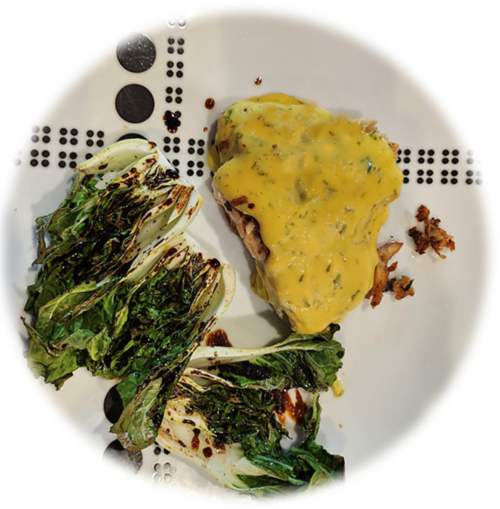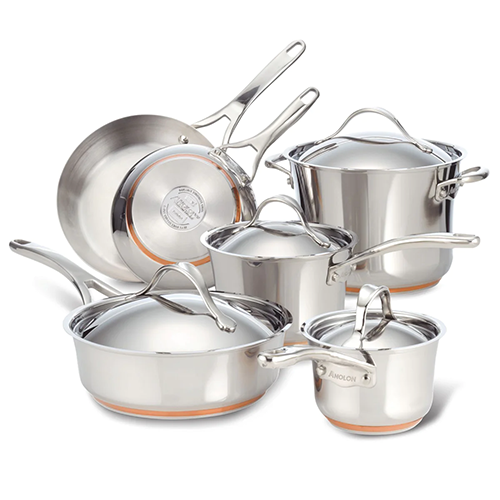April 18, 2023
Sous vide salmon, Bearnaise sauce, and roasted baby bok choy
I wanted  something easy on a Tuesday night, so I decided to sous vide a couple of salmon filets for the main course. Sous vide is so easy. This time, I bagged the salmon fillets separately because the fish proteins are more delicate than chicken, beef, or pork and if you put two fillets in one bag, they will kind of dissolve into one big filet. So, two bags, set at 115F for 60 minutes.
something easy on a Tuesday night, so I decided to sous vide a couple of salmon filets for the main course. Sous vide is so easy. This time, I bagged the salmon fillets separately because the fish proteins are more delicate than chicken, beef, or pork and if you put two fillets in one bag, they will kind of dissolve into one big filet. So, two bags, set at 115F for 60 minutes.
Of course, I wanted to sear them once they came out of the sous vide bag. I’d just gotten my new Anolon Nouvelle cookware  this morning, so this was my first chance to use it. I worked out pretty well, although this was my first time using stainless steel cookware, so it wasn’t perfect. I got the pan too hot, and then tried to flip the fillets too soon and one of them came apart. Still, they got a good sear on them and they tasted great. Clean-up was easy, even without the non-stick coating.
this morning, so this was my first chance to use it. I worked out pretty well, although this was my first time using stainless steel cookware, so it wasn’t perfect. I got the pan too hot, and then tried to flip the fillets too soon and one of them came apart. Still, they got a good sear on them and they tasted great. Clean-up was easy, even without the non-stick coating.
 I also went to the new Pan-Asian grocery store in Tulsa where I got baby bok choi among other supplies not available at the neighborhood Reasors. Anyway, I roasted a couple of them for sides, and then basted them with a sweet sauce made from soy sauce, sesame oil, balsamic vinegar, and honey.
I also went to the new Pan-Asian grocery store in Tulsa where I got baby bok choi among other supplies not available at the neighborhood Reasors. Anyway, I roasted a couple of them for sides, and then basted them with a sweet sauce made from soy sauce, sesame oil, balsamic vinegar, and honey.
Gene doesn’t like salmon, so I always try to add a sauce to bring him along. Bearnaise sauce is great with salmon but…well…it’s Bearnaise sauce, and notoriously hard to fix. I’ve made it before, and it usually turns out ok, but not always. Besides, it’s time consuming, involves an eternity of whisking, and, well, I wanted something easy.
So, off to Google looking for easy Bearnaise sauce. I found a recipe on RecipeTinEats, a website that consistently has flavorful and clear recipes. Their recipe for Bearnaise sauce used a hand-infuser to mix the clarified butter, herb-infused vinegar, and egg yolks, a process that took about two minutes as opposed to the ten minutes or more for the conventional double-boiler and whisk method. I even followed her advice and used some Ghee that I picked up at the Pan-Asian store instead of clarifying my own butter. It was easy and came out perfect.
The main shortcut in this recipe involves the hand-infuser. In the traditional method, you put your egg yolks and infused vinegar in a double-boiler, then gradually add bits of butter, whisking away all the time. The heat from the double-boiler cooks the yolks while melting the butter, and the whisking infuses the yolks, melted butter, and vinegar. But if your timing is even a little bit off, you can get scrambled eggs or a sauce that’s split instead of infused.
The RecipeTinEats method uses melted butter to cook the eggs, so it kind of reverses the normal process but gives the same result. A minute in the microwave under medium heat, and the butter is hot enough to cook the eggs. You still have to gradually add the melted butter to the yolks while the hand-infuser is running, but it’s the same reaction, consistency, and flavor.
Even Gene liked it.
I’ve taken this recipe almost verbatim from the one linked above.
Easy Bearnaise Sauce
Equipment
- 1 Hand infuser
- 1 Wire mesh strainer
Ingredients
Infused vinegar
- 1.5 TBSP White wine
- 1.5 TBSP White wine vinegar
- 1 shallot, finely sliced
- 2 TSP dried Tarragon
Bearnaise Sauce
- 2 Egg yolks
- 3/4 C Ghee (or 1 stick of butter)
- 1.5 TSP Infused vinegar
- 1 TSP dried tarragon
- 1/2 TSP Cherval (I used fresh thyme)
Instructions
Infuse the vinegar
- Place all the ingredients in a small sauce pan and bring to simmer. Simmer for at least two minutes while stirring until it is reduced by half.
- Let cool for at least ten minutes, then strain out the vinegar and dispose of the solids. You should have about 1.5 TBSP.
Bearnaise Sauce
- Place the ghee in a micro-wave mug (not plastic!), and heat at medium for one minute.If using butter instead of ghee, cut one stick up into small pieces and melt in 20-second increments for about 90 seconds. Let it sit for about 30 seconds, and milk solids will settle in the bottom. The part that's on top is (more or less) clarified butter,and that's what you'll use to make the sauce. Pour the top part into a measuring cup and discard the solids. The milk solids have already been removed from the ghee.
- While ghee is heating, add two egg yolks to a tall coffee mug and add the infused vinegar.
- With the hand-infuser, give the yolks and vinegar mixture a whiz to mix them up. Then, with the infuser running, slowly pour the ghee into yolks. Take at least a couple of minutes to pour all the ghee into the yolk mixture, moving the infuser up and down to make sure it's all mixed.
- The result will be quite thick. You may want to thin it with a TBSP of water at a time. Remember, you can make a thick sauce thinner, but can't make a thin sauce thicker! I just took the thick sauce with no thinning.
- At the end, stir the herbs into the sauce, and you're good to go.
Notes

I’ll be right over! Drooling as I go following my nose.
Thank you for the cooking lesson/recipe.